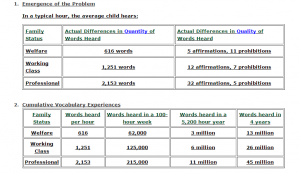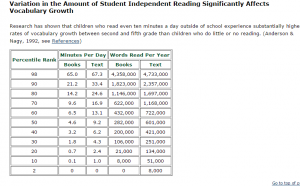A Student’s vocabulary is highly related to their ability to comprehend while reading in the upper grades. Research shows that a student in pre-school who has a deficit vocabulary will struggle with reading comprehension by third grade. (Dickinson and Tabois, 2001) Our students’ vocabulary in Kindergarten is a strong predictor of how they will perform as readers in upper elementary grades. (Cunningham and Stanovich, 1997) As you know, students who are from low socioeconomic families have said fewer words and have a smaller vocabulary foundation. From Hartley, 1995 research, a cumulative vocabulary for a 4 year old child from a professional family will know approximately 1,100 words compared to a child from a working class family who on average knows 700 words. A child from a family of low socioeconomic means, they on average know about 500 words in stark comparison. (Great Article if you want to know more about this gap.)
Click on these charts to see statistics to support the need for strong vocabulary instruction.
Images from: http://reading.uoregon.edu/big_ideas/voc/voc_what.php
Vocabulary instruction for our students facing this vocabulary gap must be accelerated, repetitive and intentional. Our instruction needs to include read aloud, explicit vocabulary instruction, word learning strategies including context clues and graphic organizers, independent reading paired with guided reading, immersion into a topic or theme with multi-sensory activities and graphics. In addition, our instruction needs to ensure Tier I vocabulary is “basic” (sight words) and needs to be learned to automaticity, Tier II words should be our focus because these are high frequency words used across grade levels (multiple meaning words/high frequency). Tier III words are the content specific words we directly teach our students.
A few Resources:
Basic Guide to the Differences in Tier I, Tier II, and Tier III words
Tier I words for K-5
Tier II words for each grade level (printable–click on the left column for grade)
More in depth information about Tier II words
So, what do we do? What are some great strategies? My next post will be a focus on vocabulary strategies for your classroom. Please share something you do for vocabulary in your classroom so I can highlight it next week in Vocabulary Take 2.

